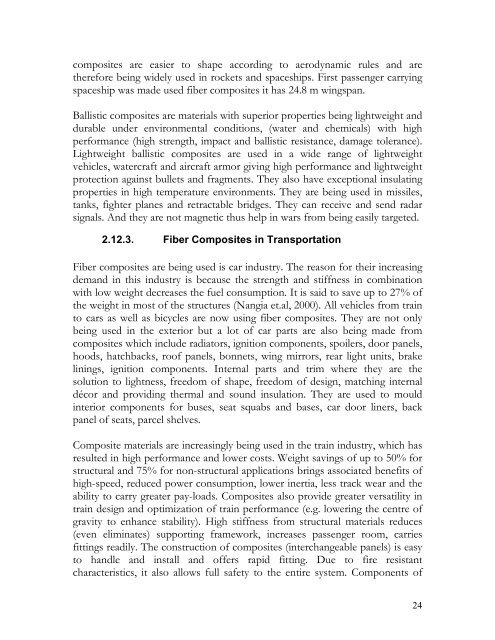Life Cycle Assessment of Fiber Composites_final__rättad
Life Cycle Assessment of Fiber Composites_final__rättad
Life Cycle Assessment of Fiber Composites_final__rättad
Create successful ePaper yourself
Turn your PDF publications into a flip-book with our unique Google optimized e-Paper software.
composites are easier to shape according to aerodynamic rules and are<br />
therefore being widely used in rockets and spaceships. First passenger carrying<br />
spaceship was made used fiber composites it has 24.8 m wingspan.<br />
Ballistic composites are materials with superior properties being lightweight and<br />
durable under environmental conditions, (water and chemicals) with high<br />
performance (high strength, impact and ballistic resistance, damage tolerance).<br />
Lightweight ballistic composites are used in a wide range <strong>of</strong> lightweight<br />
vehicles, watercraft and aircraft armor giving high performance and lightweight<br />
protection against bullets and fragments. They also have exceptional insulating<br />
properties in high temperature environments. They are being used in missiles,<br />
tanks, fighter planes and retractable bridges. They can receive and send radar<br />
signals. And they are not magnetic thus help in wars from being easily targeted.<br />
2.12.3. <strong>Fiber</strong> <strong>Composites</strong> in Transportation<br />
<strong>Fiber</strong> composites are being used is car industry. The reason for their increasing<br />
demand in this industry is because the strength and stiffness in combination<br />
with low weight decreases the fuel consumption. It is said to save up to 27% <strong>of</strong><br />
the weight in most <strong>of</strong> the structures (Nangia et.al, 2000). All vehicles from train<br />
to cars as well as bicycles are now using fiber composites. They are not only<br />
being used in the exterior but a lot <strong>of</strong> car parts are also being made from<br />
composites which include radiators, ignition components, spoilers, door panels,<br />
hoods, hatchbacks, ro<strong>of</strong> panels, bonnets, wing mirrors, rear light units, brake<br />
linings, ignition components. Internal parts and trim where they are the<br />
solution to lightness, freedom <strong>of</strong> shape, freedom <strong>of</strong> design, matching internal<br />
décor and providing thermal and sound insulation. They are used to mould<br />
interior components for buses, seat squabs and bases, car door liners, back<br />
panel <strong>of</strong> seats, parcel shelves.<br />
Composite materials are increasingly being used in the train industry, which has<br />
resulted in high performance and lower costs. Weight savings <strong>of</strong> up to 50% for<br />
structural and 75% for non-structural applications brings associated benefits <strong>of</strong><br />
high-speed, reduced power consumption, lower inertia, less track wear and the<br />
ability to carry greater pay-loads. <strong>Composites</strong> also provide greater versatility in<br />
train design and optimization <strong>of</strong> train performance (e.g. lowering the centre <strong>of</strong><br />
gravity to enhance stability). High stiffness from structural materials reduces<br />
(even eliminates) supporting framework, increases passenger room, carries<br />
fittings readily. The construction <strong>of</strong> composites (interchangeable panels) is easy<br />
to handle and install and <strong>of</strong>fers rapid fitting. Due to fire resistant<br />
characteristics, it also allows full safety to the entire system. Components <strong>of</strong><br />
24
















